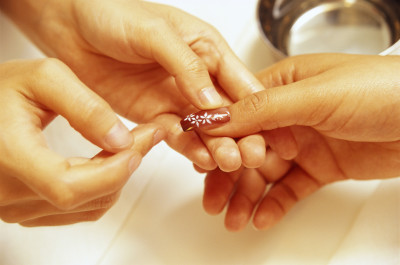Artificial nails: Dermatologists' tips for reducing nail damage
Hiding damaged nails might worsen problems
Covering up brittle, soft, or damaged nails can worsen existing nail problems.

Artificial nails can lengthen short nails, making your fingers look long and slender. They can also be hard on your nails.
To get acrylic nails (a type of artificial nail) to stick, the surface of your natural nails must be filed until they feel rough. This thins your natural nails, making them weaker. Chemicals in the products used to apply artificial nails can irritate the skin around your nails and elsewhere.
The list of health risks doesn’t end here. To remove artificial nails, you often need to soak in acetone or file them off. If you want to wear artificial nails for more than a few weeks, you’ll need touch-ups every 2 to 3 weeks to fill in the gaps that appear as your nails grow. Frequent touch-ups can seriously damage your natural nails.
In short, artificial nails can leave your nails thin, brittle, and parched.
Still, some people love the look of artificial nails. If you’re one of them, these tips from dermatologists can help you reduce the damage:
Choose soak-off gel nails instead of acrylic nails. While gel nails can cause nail brittleness, peeling, and cracking, they're more flexible than acrylic nails. This means your own nails are less likely to crack.
Go to a salon that uses an LED curing light rather than a UV curing light. Gel nails require ultraviolet (UV) light to harden. LED emits lower levels of UV radiation than a UV curing light. An LED light also cures more quickly, which reduces your UV exposure.
Ask your nail technician to skip the cuticle trimming. Cuticles are often trimmed when you get any type of manicure. That’s a problem. Cuticles protect your nails and the surrounding skin from infection. When you trim or cut your cuticles, it’s easier for bacteria and other germs to get inside your body and cause an infection. Nail infections can take a long time to clear.
Reserve artificial nails for special occasions. If you love the look of artificial nails, getting them only for a special occasion can reduce nail problems. Time without artificial nails gives your nails a chance to repair themselves.
When you’re not wearing artificial nails, a regular or French manicure can leave your nails looking fabulous.
Related AAD resources
Image
 Atopic dermatitis: More FDA-approved treatments
Atopic dermatitis: More FDA-approved treatments
 Biosimilars: 14 FAQs
Biosimilars: 14 FAQs
 How to trim your nails
How to trim your nails
 Relieve uncontrollably itchy skin
Relieve uncontrollably itchy skin
 Fade dark spots
Fade dark spots
 Untreatable razor bumps or acne?
Untreatable razor bumps or acne?
 Tattoo removal
Tattoo removal
 Scar treatment
Scar treatment
 Free materials to help raise skin cancer awareness
Free materials to help raise skin cancer awareness
 Dermatologist-approved lesson plans, activities you can use
Dermatologist-approved lesson plans, activities you can use
 Find a Dermatologist
Find a Dermatologist
 What is a dermatologist?
What is a dermatologist?